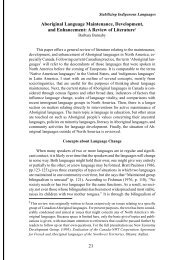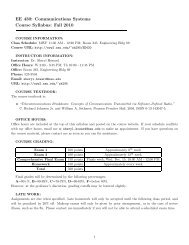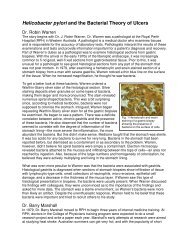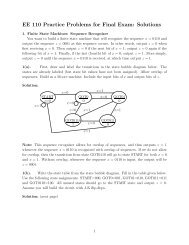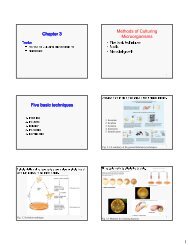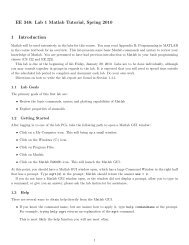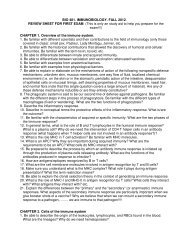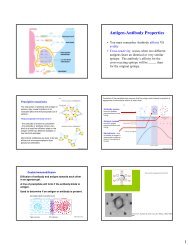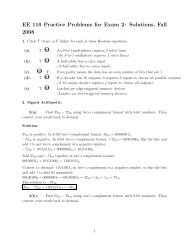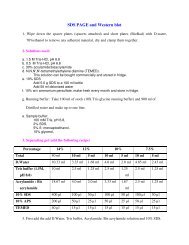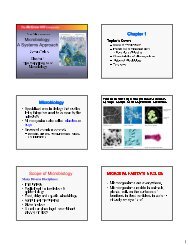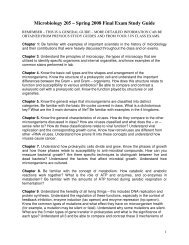Order Diplomonadidae Giardia lamblia Giardia lamblia G. lamblia ...
Order Diplomonadidae Giardia lamblia Giardia lamblia G. lamblia ...
Order Diplomonadidae Giardia lamblia Giardia lamblia G. lamblia ...
You also want an ePaper? Increase the reach of your titles
YUMPU automatically turns print PDFs into web optimized ePapers that Google loves.
<strong>Order</strong> <strong>Diplomonadidae</strong><br />
(Family Hexamitidae)<br />
1. Family is recognized by bilateral<br />
nuclei.<br />
a. Most species are parasites/commensals<br />
of invertebrates.<br />
b. However, one species is important in<br />
humans.<br />
1. A common<br />
intestinal parasite<br />
of humans, often<br />
with drastic<br />
consequences.<br />
a. Originally<br />
discovered by van<br />
Leeuwenhoek in his<br />
own stools.<br />
<strong>Giardia</strong> <strong>lamblia</strong><br />
Antony van Leeuwenhoek (1632-1723)<br />
<strong>Giardia</strong> <strong>lamblia</strong><br />
2. Distinctive appearance<br />
of trophozoites:<br />
a. Flattened ventral<br />
surface.<br />
b. 2 nuclei, ventral<br />
groove, median bodies :<br />
"monkey face."<br />
c. Flagellae: anterior,<br />
lateral, ventral, caudal.<br />
<strong>Giardia</strong><br />
<strong>lamblia</strong><br />
1. Trophs are<br />
rapid<br />
swimmers.<br />
<strong>Giardia</strong> <strong>lamblia</strong><br />
2. Cysts (the<br />
usual means<br />
for diagnosis)<br />
a. 4 nuclei,<br />
flagellae,<br />
median<br />
groove, 4<br />
median bodies.<br />
G. <strong>lamblia</strong> Life Cycle<br />
1. Direct life cycle; trophs in intestine, form<br />
cysts.<br />
2. Infection through contaminated water.
G. <strong>lamblia</strong> Life Cycle<br />
3. Reservoir hosts<br />
a. Beavers (“beaver fever”)<br />
b. Racoons<br />
c. Dogs<br />
G. <strong>lamblia</strong> Pathology<br />
1. Rapid<br />
replication<br />
by binary<br />
fission.<br />
2. Sucking<br />
disks attach<br />
to mucosa,<br />
villi.<br />
G. <strong>lamblia</strong> Pathology<br />
3. Large numbers prevent<br />
fat absorbtion.<br />
a. Symptom is "fatty"<br />
stools.<br />
b. Can cause extreme<br />
diarrhea, emaciation.<br />
c. Occasional erosion of<br />
mucosa, but this is rare.<br />
G. <strong>lamblia</strong> Prevention<br />
1. Clean water,<br />
sanitation<br />
2. Avoid "refreshment<br />
in mountain streams"<br />
3. Cure usually with<br />
antiflagellate drugs -<br />
Flagyl and others;<br />
mostly metronidazole<br />
and relatives.<br />
Hexamita meleagridis<br />
1. Parasite of young<br />
galliform birds<br />
2. Similar to <strong>Giardia</strong><br />
in life cycle,<br />
morphology with<br />
exceptions.
Hexamita meleagridis<br />
a. Causes stunting, malnutrition, death in<br />
birds, especially when kept in high<br />
concentrations, as is true with most modern<br />
poultry farms.<br />
Phylum Axostylata<br />
a. Axostyle (central<br />
filament running<br />
through cell) made of<br />
microtubules.<br />
b. Usually mucous or<br />
intestinal parasites or<br />
commensals.<br />
<strong>Order</strong> Trichomonadida<br />
(Family<br />
Trichomonadidae)<br />
a. Anterior flagellae,<br />
often several.<br />
b. Undulating<br />
membrane.<br />
c. Axostyle, often<br />
protrudes to posterior.<br />
Trichomonas tenax<br />
1. Occurs primarily in<br />
humans.<br />
a. Mouth commensal.<br />
b. Spread through<br />
kissing, use of other’s<br />
toothbrushes.<br />
c. Not usually<br />
pathological, common:<br />
15% in NY.<br />
Trichomonas vaginalis<br />
1. Also parasitic in<br />
humans.<br />
a. A venereal disease.<br />
b. Often asymptomatic,<br />
but can cause sterility if<br />
untreated.<br />
c. Causes greenish or<br />
whitish discharge from<br />
penis or vagina.<br />
T. vaginalis trophs in discharge
Strawberry cervix caused by T. vaginalis<br />
Trichomonas vaginalis<br />
d. Usually spread via<br />
sexual intercourse, but<br />
also by dirty linen.<br />
e. Cured by<br />
simultaneous treatment<br />
of sexual partners with<br />
anitflagellate drugs<br />
(Metranidazole=Flagyl)<br />
Trichomonas vaginalis<br />
f. Greater<br />
susceptibility as<br />
vaginal pH becomes<br />
more basic – thus<br />
variable infection rates<br />
over menstrual cycle.<br />
1. Trichs shift pH<br />
lower after infection.<br />
Trichomonas vaginalis<br />
g. Fronske Health<br />
Center reports very<br />
low frequency (none<br />
last year).<br />
h. Coconino Health<br />
Department reports "a<br />
few cases per month."<br />
Pentatrichomonas hominis<br />
3.Intestinal parasite of<br />
humans.<br />
a. Used to be<br />
Trichomonas hominis.<br />
b. Gut parasite,<br />
usually not severe,<br />
also in cats, dogs, etc.<br />
Pentatrichomonas hominis<br />
c. Spread via<br />
contaminated water,<br />
associated with other<br />
gut parasites acquired<br />
this way.<br />
Often responsible for<br />
diarrhea in cats; but<br />
can be caused by other<br />
flagellates.
Tritrichomonas foetus<br />
4. Usually found in<br />
cattle.<br />
a. Used to be very<br />
common in european<br />
and US cattle.<br />
Tritrichomonas foetus<br />
b. Often spread by<br />
breeding practices; +<br />
bull can infect many<br />
cows.<br />
c. Causes early<br />
abortion; can be<br />
cleared if cow sheds<br />
all membranes at birth.<br />
Tritrichomonas foetus<br />
1. If not, can cause<br />
permanent sterility.<br />
2. Bull can be<br />
treated, but is<br />
expensive, time<br />
consuming and risky.<br />
3. Involves rubbing<br />
antitrichimonal salve<br />
into penis repeatedly.<br />
Hyperparasites<br />
1. A situation in which<br />
a parasite is infected<br />
with its own parasite.<br />
2. Possibly because<br />
energy transfer is<br />
possible,<br />
hyperparasites are<br />
often very successful.<br />
matryoshka<br />
Hyperparasites<br />
3. Can permit transfer<br />
of hyperparasite to<br />
new host - the host of<br />
the parasitized<br />
parasite.<br />
a. The parasitized<br />
parasite becomes a<br />
vector.<br />
Hyperparasites<br />
Two good examples in<br />
this order:<br />
1. Family<br />
Monocercomonadidae<br />
a. Named for presence<br />
of basal flagellar<br />
structures common to<br />
the group.
Histomonas meleagridis<br />
1. Different from<br />
Hexamita meleagridis<br />
2. Epidemiology<br />
a. No cyst stage, troph<br />
is fragile.<br />
b. Seems to be<br />
transmitted in the egg<br />
of a nematode.<br />
Histomonas meleagridis<br />
Histomonas meleagridis<br />
Histomonas<br />
lesions on liver<br />
Histomonas<br />
lesions on cecum<br />
Heterakis gallinarium<br />
1. H.m. troph invades<br />
gonads of this<br />
nematode via gut.<br />
a. Becomes inclosed<br />
in eggs.<br />
b. Eggs are shed in<br />
bird feces.<br />
Heterakis gallinarium &<br />
Histomonas meleagridis<br />
2. Nematode eggs<br />
hatch in soil,<br />
a. Flagellates<br />
replicate within<br />
nematodes, invade<br />
male tissues<br />
b. Are transmitted to<br />
female nematodes<br />
sexually.
Heterakis gallinarium &<br />
Histomonas meleagridis<br />
3. Flagellates are<br />
also a venereal<br />
disease of<br />
nematodes.<br />
a. Nematode eggs<br />
may also lay<br />
dormant in soil.<br />
b. If eaten by bird<br />
- releases both<br />
nematode and<br />
troph.<br />
4. If eaten by an<br />
earthworm:<br />
a. Nematode<br />
larvae hatch, lie<br />
dormant in<br />
tissues.<br />
b. Flagellates<br />
are still<br />
associated with<br />
nematodes.<br />
Heterakis gallinarium &<br />
Histomonas meleagridis<br />
Heterakis gallinarium<br />
3. If<br />
earthworm<br />
is eaten by<br />
a bird<br />
(domestic<br />
or wild).<br />
a. Both<br />
parasites<br />
infect bird.<br />
Terminology<br />
1. Nematode is a<br />
vector – it transmits<br />
flagellates to bird.<br />
a. Nematode is also<br />
an intermediate host.<br />
b. Retains the<br />
flagellate in infective<br />
condition until it can<br />
be transmitted to a<br />
bird.<br />
Terminology<br />
2. Earthworm is also<br />
an intermediate host.<br />
a. It retains both<br />
nematodes and<br />
flagellates in infective<br />
condition.<br />
Terminology<br />
3. Nematode is a also<br />
definitive host.<br />
This is where<br />
flagellates engage in<br />
sexual reproduction.
Terminology<br />
Terminology<br />
4. Flagellate is a<br />
venereal disease.<br />
a. Earthworm is an<br />
intermediate host - and<br />
a paratenic host<br />
b. Because worms<br />
and flagellates can live<br />
in them indefinitely.<br />
4. Chickens serve as<br />
reservoir hosts for<br />
turkeys.<br />
a. Chickens retain<br />
infective stages that<br />
are also infective to<br />
turkeys.<br />
1. Another<br />
flagellate that<br />
resembles an<br />
amoeba.<br />
2. Seems to<br />
have similar<br />
relationship<br />
with<br />
nematodes.<br />
Dientamoeba fragilis<br />
Dientamoeba fragilis<br />
a.In this case the<br />
nematode is<br />
Enterobius<br />
vermicularis, the<br />
human pinworm.<br />
b. More on this later.<br />
<strong>Order</strong> Hypermastigia<br />
a. Makes sense,<br />
means "too many<br />
flagellae"!<br />
b. Commensals of<br />
termites, other wood<br />
eaters.<br />
c. Spread through the<br />
colony by anal and<br />
oral trophallaxis.<br />
<strong>Order</strong> Hypermastigia<br />
d. Common genus:<br />
Trichonympha
Subphylum Opalinata<br />
<strong>Order</strong> Opalinida<br />
(Family Opalinidae)<br />
1. Opalina<br />
a. A bit of redundancy<br />
in systematics!<br />
b. A cloacal and rectal<br />
parasite of amphibians.<br />
Opalina ranarium<br />
Subphylum Opalinata<br />
c. Morphology - like<br />
that of ciliates<br />
1. Large, with oblique<br />
rows of cilia<br />
2. Multinucleate<br />
1. Nuclei are all the same,<br />
unlike true ciliates who have<br />
macro and micronucleus.<br />
2. Sexual reproduction<br />
differs from that of ciliates.<br />
a. No swapping of<br />
micronuclei - syngamy<br />
instead.<br />
3. Asexual reproduction is<br />
also different.<br />
However:<br />
Reproduction<br />
and Transmission<br />
1. Asexual reproduction in<br />
most seasons in frogs.<br />
2. In spring:<br />
a. Hormonal changes in<br />
breeding hosts induce<br />
formation of precysts.<br />
b. Cysts shed in feces are<br />
eaten by tadpoles.<br />
c. Fusion in gut, resumption<br />
of asexual reproduction<br />
3. Pathology unclear.



